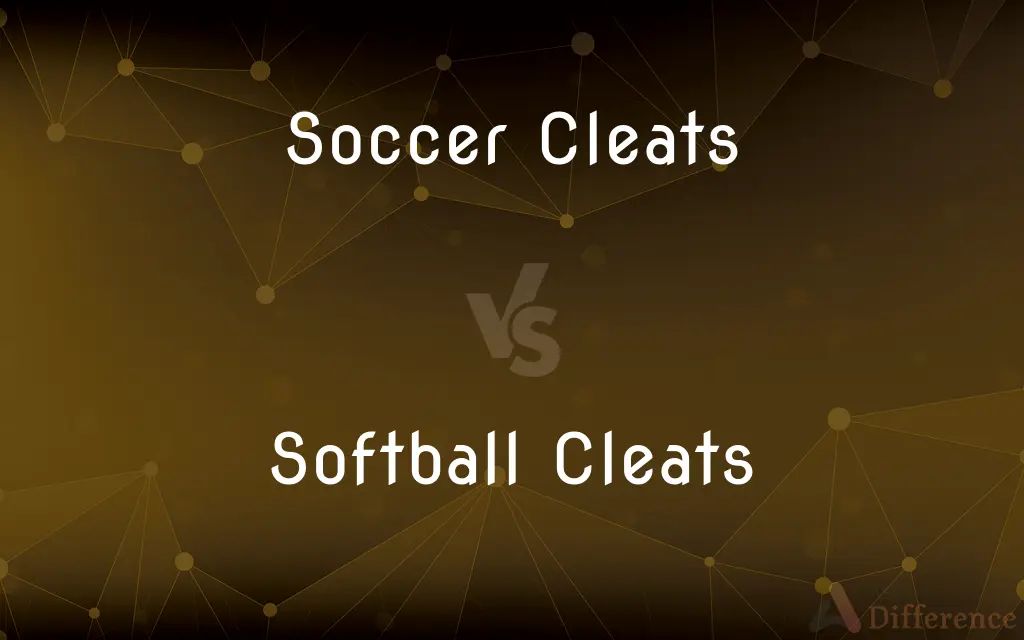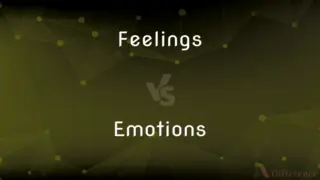Soccer Cleats vs. Softball Cleats — What's the Difference?
By Maham Liaqat & Fiza Rafique — Published on August 10, 2024
Soccer cleats are designed for agility and ball control on grass, featuring low-cut styles and non-removable studs, whereas softball cleats come in various cuts with options for metal or plastic spikes for traction on dirt and grass.

Difference Between Soccer Cleats and Softball Cleats
Table of Contents
ADVERTISEMENT
Key Differences
Soccer cleats are specifically designed to enhance performance on the soccer field. They typically have a low-cut design to allow for maximum ankle mobility, facilitating quick changes in direction and speed. The studs or cleats on soccer shoes are made to provide traction on grass surfaces and are often made of rubber or hard plastic. These studs are usually shorter and more conical in shape to help in quick pivoting. Soccer cleats rarely have a toe cleat at the front because it can make maneuvers with the ball more challenging.
Softball cleats, tailored for the game of softball, vary in their design to accommodate different playing surfaces, such as dirt or grass. They come in low-cut, mid-cut, and high-cut styles, offering varying levels of ankle support. The cleats on softball shoes can be made of metal, rubber, or plastic, depending on the league rules and player preference. Metal cleats are often preferred for their superior traction on dirt and grass surfaces. Softball cleats feature a toe cleat at the front, which helps players gain additional leverage when running the bases or fielding.
The choice between soccer and softball cleats depends on the specific requirements of the sport being played. Soccer cleats prioritize agility and ball control, with designs that minimize any obstruction during play. Softball cleats focus on traction and stability, with more diverse designs to suit different field conditions and player roles. It's important for athletes to choose the appropriate type of cleat to optimize their performance and reduce the risk of injury.
Comparison Chart
Design
Low-cut for ankle mobility
Available in low-cut, mid-cut, and high-cut for varying ankle support
Stud/Cleat Material
Rubber or hard plastic
Metal, rubber, or plastic
ADVERTISEMENT
Stud/Cleat Shape
Conical for quick pivoting
Varied, often with a toe cleat for leverage
Surface Compatibility
Grass
Dirt and grass
Toe Cleat
Absent
Present
Purpose
Agility and ball control
Traction and stability
Ankle Support
Minimal to allow for agility
Varies; more support in mid and high-cut designs
Compare with Definitions
Soccer Cleats
Soccer cleats lack a front toe cleat to aid in ball handling.
Without a toe cleat, soccer cleats make dribbling and passing more efficient.
Softball Cleats
Softball cleats are designed for traction on both dirt and grass surfaces.
Her softball cleats provided excellent grip on the infield dirt.
Soccer Cleats
Soccer cleats are designed for optimal performance on grass fields.
He wore his new soccer cleats for the tournament on the natural grass field.
Softball Cleats
They come in various cuts for different levels of ankle support.
Choosing high-cut softball cleats for better ankle stability during the game.
Soccer Cleats
Conical studs provide agility and ease of pivot.
The conical studs on his soccer cleats helped him maneuver easily around opponents.
Softball Cleats
Metal cleats are common for superior traction.
The metal cleats on her shoes dug into the ground, preventing slips.
Soccer Cleats
They feature a low-cut style for enhanced ankle mobility.
The low-cut design of soccer cleats allows for quick directional changes.
Softball Cleats
A toe cleat at the front assists in quick sprints and plays.
The toe cleat helped her accelerate quickly when stealing bases.
Soccer Cleats
They are made for precision and control in soccer.
The design of soccer cleats supports the precision needed for soccer's intricate plays.
Softball Cleats
Softball cleats cater to the demands of softball, including base running and fielding.
Her softball cleats were designed to withstand the quick stops and starts of the game.
Common Curiosities
Are metal cleats allowed in soccer?
No, metal cleats are not typically allowed in soccer due to the increased risk of injury during play.
Why do soccer cleats not have a toe cleat?
Soccer cleats lack a toe cleat to improve the player's ability to handle the ball without interference, aiding in precise kicks and dribbling.
How do I choose between soccer and softball cleats?
Consider the sport's specific demands, the type of surfaces you'll be playing on, and your need for ankle support or mobility. Also, adhere to any league-specific regulations regarding cleat type.
How important is the material of the cleat?
The material affects the cleat's durability, weight, and performance on different playing surfaces, making it an important consideration for athletes.
Can I use soccer cleats for softball?
While soccer cleats may be used in softball due to the absence of a toe cleat, they may not provide the same level of traction and support as softball-specific cleats, especially on dirt surfaces.
Can softball players use any type of cleat?
Softball players can choose between metal, rubber, or plastic cleats, but the choice often depends on league regulations and personal preference for traction and comfort.
Why might a softball player choose high-cut cleats?
A softball player might choose high-cut cleats for added ankle support, which can be beneficial for preventing injuries during quick movements and changes in direction.
Is there a performance difference between low-cut and high-cut cleats in softball?
The main difference lies in the level of ankle support; low-cut cleats offer more mobility, while high-cut cleats provide greater stability and protection.
Are there cleats designed for both soccer and softball?
While there are no cleats specifically marketed for both sports due to their different requirements, soccer cleats may be used in softball in some cases, albeit not optimally for all conditions.
Do cleat choices vary for different positions in softball?
Yes, players may choose different cleat types based on their role; for example, outfielders might prefer metal cleats for better traction on grass and dirt, while infielders might opt for plastic or rubber cleats for quick lateral movements.
Share Your Discovery

Previous Comparison
Actin Filaments vs. Microtubules
Next Comparison
Feelings vs. EmotionsAuthor Spotlight
Written by
Maham LiaqatCo-written by
Fiza RafiqueFiza Rafique is a skilled content writer at AskDifference.com, where she meticulously refines and enhances written pieces. Drawing from her vast editorial expertise, Fiza ensures clarity, accuracy, and precision in every article. Passionate about language, she continually seeks to elevate the quality of content for readers worldwide.












































